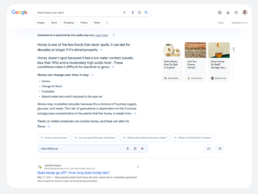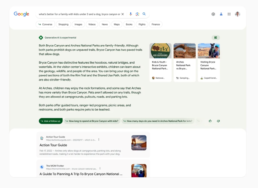There’s a good chance you’ve searched for something in Google today, as the website handles a stunning 5.9 million searches every minute. So, you may have noticed that your search experience was a bit different than what you’re used to. That’s because Google is rolling out its new and improved search results: SGE.
SGE is not only Google’s newest improvement, but it’s also the most significant development that Google has had involving AI. Google has developed a new Gemini language model for its Search page, and the results expand upon the Search process in ways that were previously unachievable.
What is SGE?
SGE stands for Search Generative Experience. In short, Google is integrating the power of artificial intelligence into its classic Search experience. You’ll still see the traditional web results page when you enter a query, but you’ll also be able to:
- Ask more descriptive and complex questions
- Get quick summaries of topics with links for further research
- Get help starting a project, like writing a draft or generating an image
- Ask follow-up questions and try suggested next steps

Google presented this example of SGE’s new formatting, known as AI Overviews. The query is answered directly, but you can also learn more about the subject and ask related questions for a deep dive on the topic.
You may have already seen SGE in action during your own Google searches. The technology is already rolling out to millions of searchers throughout the United States just this week. By the end of 2024, Google expects SGE to reach more than one billion users.
SGE is starting as an experiment in Google’s Search Labs. For now, it’s only in the United States, and it’s only in English. But as the company gets feedback and makes improvements, it will introduce SGE to markets around the world.
What Can SGE Do?
SGE has tons of features to help improve the search experience. For starters, you can now ask multi-part questions and get more detailed answers than before. Take this query: “What’s better for a family with kids under 3 and a dog: Bryce Canyon or Arches?” Normally, you might break down this query into several different searches. But now, Google can piece together the answers for you:

Another helpful feature is planning assistance. Sometimes, the hardest part of a project is getting started. SGE can help you outline an essay, create a weekly meal plan, or make a packing checklist for your vacation. Google will scour the internet for the most relevant resources and compile a customized response.
It’s no secret that visuals are the key to keeping your audience’s attention. Now, Google will let users ask questions via video. You might be having a tech issue or other query that’s hard to put into text but better explained aloud. This new feature not only improves the search process in general, but it can save users a lot of time and frustration.
Finally, SGE has the ability to organize search results in easy-to-digest categories. You can search for a broad query like “brunch in Nashville,” and your results will be neatly categorized based on location, price point, or whatever other categories SGE finds relevant.
Is SGE Safe?
Anything in its infancy comes with its share of questions. AI can be frighteningly smart, but Google has made it a point to install their AI Principles, ensuring that the technology is used responsibly.
Google has put many quality checks in place, including human input and evaluation, search quality systems, carefully formulated policies, and more. The company has also acknowledged that SGE will have its limitations but will continue to grow and improve in the months to come.
SGE's Impact on Search
SGE has been presented as a method of enhancing search quality. But many businesses rely quite heavily on Google search traffic, and this new update has them worried. Since SGE results are the first thing users see, they might not do any further research. So, websites that used to be easily visible are now losing clicks because users are getting their answers right away.
One of the great capabilities of SGE is the ease with which it tackles complicated queries. So, there’s a likelihood that top-of-funnel content (long-tailed, question-based search queries) will be impacted. There may be a less noticeable impact of bottom-funnel content, which involves conversion-focused keywords.
There are several steps you can take to optimize your website to appeal to SGE and put your website in front of the best potential customers. First, Q&A formats are increasingly appealing to Google because of their direct answers. If you’re writing a blog post answering a common question in your industry, plainly address that question in the first couple of paragraphs.
On the other hand, you can also appeal to SGE when tackling comprehensive questions. Describe an entire customer journey from start to finish to position your website as an authority in the eyes of SGE.
While the writing side of SEO is being impacted by the SGE rollout, don’t neglect your site’s technical SEO. Google’s AI “crawls” the content on websites to find the best matches for queries, just as the traditional web crawlers do. Ensure that your content is easy for crawlers to access and render. Otherwise, you’ll get passed over for a site that’s easier to navigate.
Looking Forward
The impact of SGE can be summed up by this quote from Google’s announcement of the rollout: “With new breakthroughs in generative AI, we’re again reimagining what a search engine can do.”
The introduction of SGE is an exciting development, but only time will tell how the search process is permanently impacted. It may take time to adjust to the change, but in the end, businesses will have to adapt for AI in order to remain visible in search and attract new customers from all across the Web.
At OneClick Media, we’ll be keeping up with these changes and recommending strategies to help you optimize your website in turn.

